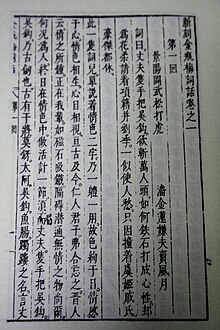
Back جين بينغ ماي Arabic Кветкі слівы ў залатой вазе Byelorussian Jin Ping Mei BJN Jin Ping Mei Catalan Ťin Pching Mej Czech Jin Ping Mei German Jin Ping Mei Esperanto Jin Ping Mei Spanish Jinpingmei Finnish Jin Ping Mei French
 Wanli era edition | |
| Author | Lanling Xiaoxiao Sheng ("The Scoffing Scholar of Lanling", pseudonym) |
|---|---|
| Original title | 金瓶梅 |
| Language | Written vernacular Chinese |
| Genre | Historical fiction, erotic fiction |
| Set in | China, 1111–1127 |
Publication date | c. 1610 |
| Publication place | China (Ming dynasty) |
Published in English | 1972, 2013 |
| Media type | |
| 895.1346 | |
| LC Class | PL2698.H73 C4713 |
Original text | 金瓶梅 at Chinese Wikisource |
| Jin Ping Mei | |||||||||||||||||||
|---|---|---|---|---|---|---|---|---|---|---|---|---|---|---|---|---|---|---|---|
| Chinese | 金瓶梅 | ||||||||||||||||||
| Literal meaning | "The Golden Vase Plum" | ||||||||||||||||||
| |||||||||||||||||||
Jin Ping Mei (Chinese: 金瓶梅)—translated into English as The Plum in the Golden Vase or The Golden Lotus—is a Chinese novel of manners composed in vernacular Chinese during the latter half of the 16th century during the late Ming dynasty (1368–1644). Consisting of 100 chapters, it was published under the pseudonym Lanling Xiaoxiao Sheng (蘭陵笑笑生), "The Scoffing Scholar of Lanling,"[1] but the only clue to the actual identity is that the author hailed from Lanling County in present-day Shandong.[2] The novel circulated in manuscript as early as 1596, and may have undergone revision up to its first printed edition in 1610. The most widely read recension, edited and published with commentaries by Zhang Zhupo in 1695, deleted or rewrote passages to help understand the author's intentions.[3]
The explicit depiction of sexuality garnered the novel a notoriety akin to Lady Chatterley's Lover and Lolita in the West, but critics such as the translator David Tod Roy see a firm moral structure which exacts retribution for the sexual libertinism of the central characters.[4]
Jin Ping Mei takes its name from the three central female characters—Pan Jinlian (潘金蓮, whose given name means "Golden Lotus"); Li Ping'er (李瓶兒, literally "Little Vase"), a concubine of Ximen Qing; and Pang Chunmei (龐春梅, "Spring plum blossoms"), a young maid who rose to power within the family.[2] Chinese critics see each of the three Chinese characters in the title as symbolizing an aspect of human nature, such as mei (梅), plum blossoms, being metaphoric for sexuality.
David Tod Roy calls the novel "a landmark in the development of the narrative art form—not only from a specifically Chinese perspective but in a world-historical context ... noted for its surprisingly modern technique" and "with the possible exception of The Tale of Genji (c. 1010) and Don Quixote (1605, 1615), there is no earlier work of prose fiction of equal sophistication in world literature."[5] Jin Ping Mei is considered one of the six classics of Chinese novels.
- ^ Michael Dillon, China: A Cultural and Historical Dictionary, Routledge, 1998, ISBN 0-7007-0439-6, pp.163–164
- ^ a b Lu (1923) p.408
- ^ Roy (2006), p. xx–xxi.
- ^ Charles Horner (October 1994). "The Plum in the Golden Vase, translated by David Tod Roy". Commentary Magazine.
- ^ Roy (2006), p. xvii–xviii.